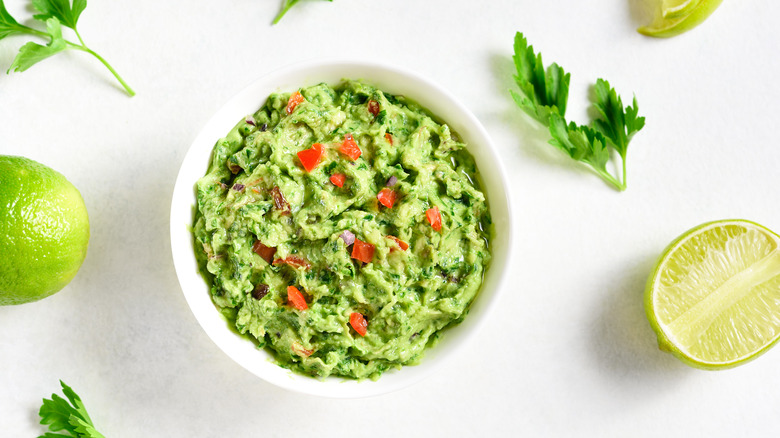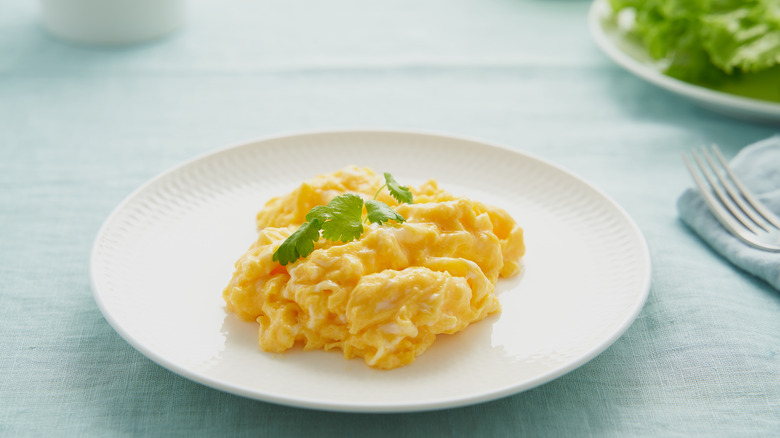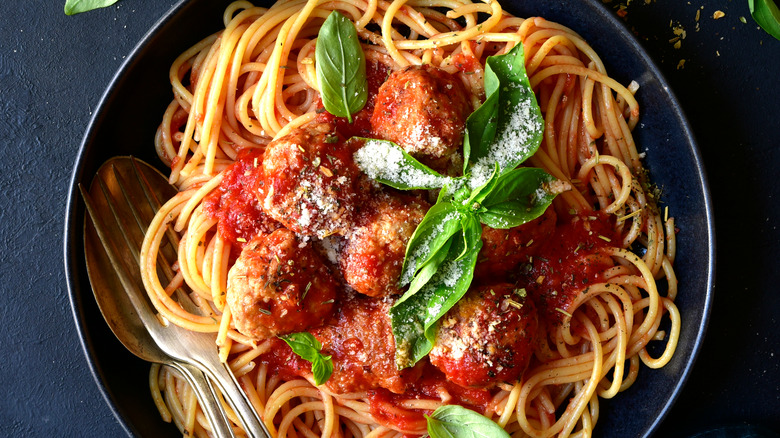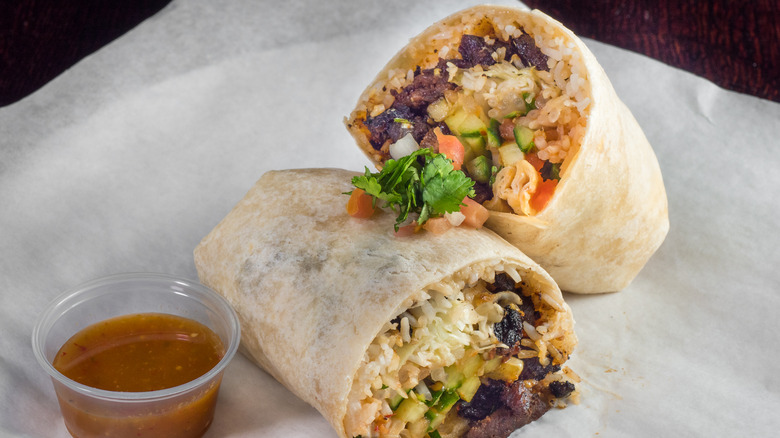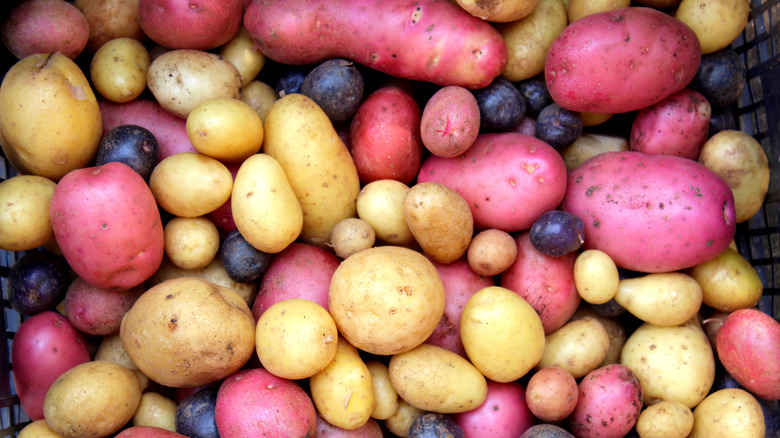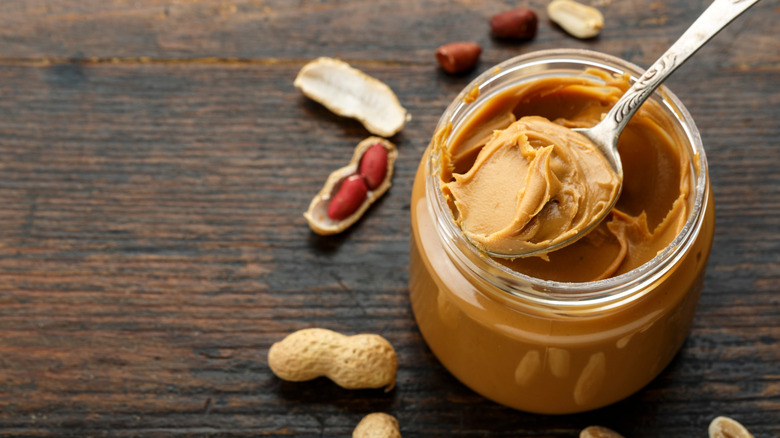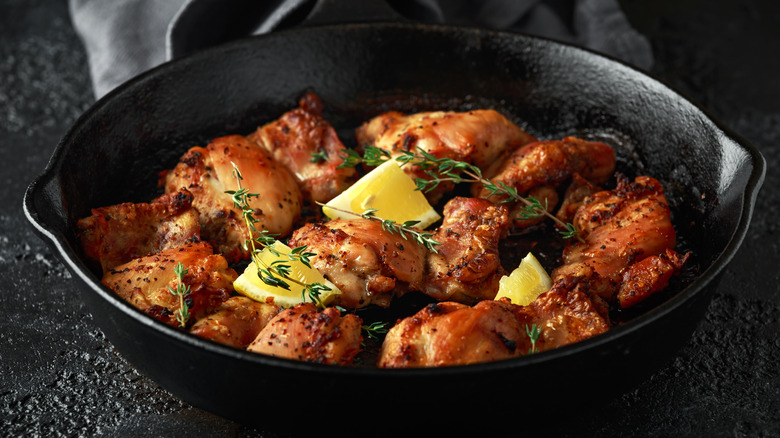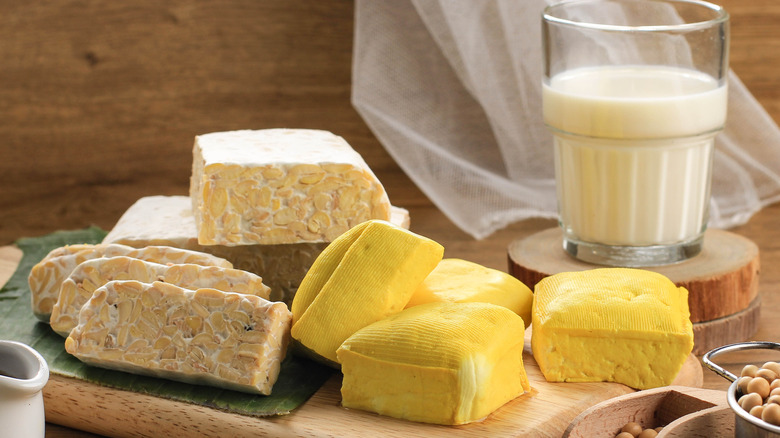Foods That Are Actually Healthier Than You Think
Changing your lifestyle can be daunting — especially when it comes to nutrition. You may think that eating healthy is all salads, no restaurants, and no fun. But eating healthy doesn't have to be boring.
The American Academy of Dietetics and Nutrition stresses variety in healthy eating. Creating a healthy plate should include a mix of foods from all food groups, including fruits and vegetables, whole grains, lean protein, and low-fat dairy (via Eat Right). That means you're not eliminating one whole food group for the sake of dieting (we're looking at you, low-carb diets).
Contrary to popular belief, eating healthy can actually be enjoyable. At first, it may seem challenging, but eventually your body and mindset will see a shift. You will likely start to feel better with higher energy levels and you can still enjoy your favorite foods in moderation with adaptations to portion size (via Verywell Fit). In fact, you may be surprised to learn that some of your favorite foods are healthier than you think. With a few modifications, they can certainly be a part of your well-rounded diet.
Guacamole and other dips
By making some slight modifications, you can actually enjoy your appetizer tray and feel better about it. Although avocados are known for being higher in fats, they don't contain the same fat you'd find in a fast-food meal. Avocados are high in heart-healthy monounsaturated fats, as well as tons of other vitamins and minerals like folate, fiber, potassium, and vitamins B-6, C, E, and K-1 among many others (via Cleveland Clinic). This means guacamole can be a great snack — especially if you make it yourself with fresh ingredients to ensure it's not packed with high sodium or preservatives.
If guacamole isn't your thing, you can healthify other dips. Many classics like spinach and artichoke or buffalo chicken dip are based with heavy cream cheese, sour cream, ranch, or mayonnaise. But if you swap out those heavier options for Greek yogurt and add veggies directly into the dip, you may not even know they're the lighter versions. You can leverage seasonings like onion or garlic to pack the flavor and forgo the chips for fresh vegetables, fruit, or a corn chip alternative to make it low-calorie and more nutritious (via Anytime Fitness).
Eliminating the dip portion entirely and going with popcorn can also be a perfect, whole-grain snack option — so long as you don't load it with butter and salt. Registered dietitian nutritionist Jennifer Glockner told Bustle that air-popped popcorn is low in calories, high in fiber, and can be just as delicious as movie theater popcorn with some olive oil and spices.
Breakfast classics
Eggs have gotten a bad rap for cholesterol levels over the years, but they may actually help improve your HDL ("good") cholesterol and lower your risk of heart disease (via Healthline). One study cited by Healthline even found that having eggs for breakfast reduced calorie intake later in the day and caused fat loss.
Eggs are also a good source of protein and tons of other vitamins and minerals like choline, vitamin B, A, selenium, and more. So don't be afraid of grabbing a couple eggs and whipping them up the way you like. Even egg casseroles can be a healthy breakfast choice. Just try to stick to crustless quiches and casseroles full of healthy veggies (via Anytime Fitness).
If you prefer a sweeter breakfast, don't fear: You can still get your flapjack fix! While not as nutrient-dense as eggs, you can avoid empty calories by limiting the sugary toppings and syrup on your pancakes. Also try making them yourself with whole grain or whole wheat flour for fiber, adding nuts and fruit for best nutritional benefits (via Eating Well).
You also have other pancake alternative options like the Paleo dieter's favorite 3-ingredient pancakes that call for bananas and white flour alternatives like almond or oat flour. Try topping your pancakes with your nut butter of choice for an extra protein boost.
Italian dishes
When you think of Italian food, your mind may immediately go to the family-style portions of pasta casserole dishes full of delicious cheese, carbohydrates, and meat. While many Italian dishes may be full of these tasty ingredients, these meals can be healthy. Tomato sauce contains the plant-based antioxidant lycopene, lean beef contains iron and protein, and pasta packs an energy boost from the carbohydrates (via Food Network). If you use lean meat like lean ground beef or ground turkey, replace the white pasta with whole wheat, and watch your sodium, you can enjoy portions of spaghetti and meatballs in moderation.
Lasagna also offers some of the same nutritional perks and has its own set of alternatives to maximize health. You can make your lasagna full of vegetables — even replace your noodles with zucchini or eggplant if you're feeling daring. Some people also use protein-packed cottage cheese instead of the dairy milk-fat ricotta cheese. Just be sure to check your tomato sauce to monitor your sodium intake (via Anytime Fitness).
And we can't forget about pizza! While you may be thinking of the greasy slice you enjoy after a night out on the town, pizza actually offers some healthy customizations. The average amount of protein in a slice of pizza is 12 grams thanks to the cheese, registered dietitian Chelsey Amer told Insider. You can add more nutrition to your slice by adding lots of fresh vegetable toppings and choosing a thin crust or whole-wheat crust for higher fiber levels to fill you up.
Burritos and other handheld foods
Burritos can be a good choice for breakfast, lunch, or dinner. One tortilla full of beans, small portions of meat or eggs, rice, and vegetables can cover all the food groups (via Food Network). To make this option even healthier, skip the sour cream and cheese and try a whole wheat tortilla instead of a regular flour tortilla.
You likely won't find a fast-food burger on top of any healthy food lists, but when done correctly burgers can actually be okay too. Choose a lean ground meat like beef, turkey, or chicken with less than 10 grams of fat and keep your serving size at 4 ounces (via OpenFit). When making your own patties, you can also sneak in some extra vegetables like mushrooms or zucchini, as well as grains like quinoa or black beans.
The toppings and condiments are where burgers can steer into unhealthy territory, however. Eliminate extras like bacon or cheese for fresh vegetables like tomatoes, lettuce, onion or peppers. The large white bread bun can also be problematic, but you can choose a low-carb whole wheat alternative, or wrap in lettuce leaves. Sandwiches and wraps at restaurants can also be deceiving, as they typically are much larger than a sandwich you'd make for yourself at home. That means more sodium, calories, and fat (via Consumer Reports). Choose a side other than chips or fries, steer clear of the processed lunch meats and cut back on cheeses and condiments.
Potatoes
When you think of potatoes, you probably envision a side of french fries or a bag of potato chips. While frying isn't the healthiest cooking option, potatoes themselves can actually be nutritious. The specific nutritional profile can vary depending on your variety of potato, but generally speaking, potatoes are a good source of antioxidants, carbohydrates, fiber, vitamin C, vitamin B6, potassium, and manganese (via Healthline). By keeping the skin on the potato when cooking, you maximize these nutritional benefits. Potatoes can also be very satisfying, keeping you fuller for longer. But be mindful of your portions. These have been linked to weight gain in some studies, according to Healthline.
Baking, boiling, or steaming your potatoes are your best bets for health, but they don't have to be plain and boring. You can top your baked potato with vegetables like broccoli or peppers and use plain Greek yogurt instead of sour cream. It is wise to skip the cheese and bacon if trying to really keep calories and fats down. You can also opt for the potato varieties with vibrant colors like sweet potatoes, which also contain beta carotene to fight inflammation and fewer calories (via Anytime Fitness).
If potato salad is your favorite side dish at picnics and barbecues, don't fear — there are lighter versions out there. Opt for the low-fat, low-calorie mayonnaise to dress your salad or omit the mayo entirely for a vinegar-based salad dressing (via WebMD).
Butter and nut butters
Tried and true peanut butter can be high in saturated fats, calories, and sodium if you are not careful with your selection. However, PB also includes heart-healthy fats like monounsaturated and polyunsaturated, as well as protein, magnesium, phosphorus, zinc, niacin, and more (via Medical News Today). It's been linked to weight loss, heart health improvement, and it's even helpful for those with diabetes. Peanut butter is also popular in the bodybuilding and weightlifting community. To get all the perks of peanut butter without some of the negative nutritional aspects, go for an unsalted, no sugar added, pure peanut butter that boasts just nuts and a few other ingredients. Use peanut butter as a topping for numerous snacks or dishes.
Nut butters can be great, but what regular ole butter? It was once a big no-no, but these days, some say it may not be as unhealthy as we once thought. In fact, it could be better than the oils that many people use in place of butter. "It makes foods like vegetables taste better, and the saturated fatty acid, CLA (conjugated linoleic acid), helps improve body composition and leanness," Rebecca Scritchfield, registered dietitian nutritionist, told Men's Journal. "Adding a teaspoon to sautéed vegetables will also help your body absorb fat-soluble vitamins (E, A, D and K)." Scritchfield advises going for butter derived from grass-fed cows with less saturated fat and more good fatty acids. These can be stored in your muscles and used for fuel during exercise.
Dark meat chicken
White meat chicken has the reputation for being the healthier chicken option. But your poultry intake doesn't necessarily have to be all chicken breasts. Dark meat is actually healthier than you may think — it is the skin that is the main health issue with chicken of all cuts (via Business Insider).
Fat is necessary for us to consume to function for energy, so not all fat is unhealthy. Dark meat chicken contains twice as much healthy unsaturated fat (and saturated fat) as light meat. It also contains more iron, riboflavin, thiamine, vitamins B6 and B12, and zinc, the National Chicken Council revealed to Business Insider. The taste of dark meat may also help keep the cooking method as healthy as possible, as its juiciness may lend itself to needing fewer extras. "It's more succulent and full of flavor, which allows it to easily stand on its own without being smothered in sugary, salty sauces," Marisa Moore, registered dietitian nutritionist, told Women's Health. "Dark meat will also stand up to broiling without drying out."
You will want to be mindful of how you cook your dark meat, though. Frying it up in oil or butter can make any cut of poultry an unhealthy option. Also, be sure to select the skinless chicken thighs for your cut of meat if trying to keep it healthy, or remove the skin after cooking.
Coffee and alcohol (in moderation)
Drinks can be a hidden labyrinth for calories and sugar, making it difficult to keep on the healthy track. But what if you're tired of just water with every meal? Luckily, some drinks contain health benefits to consider.
While there has been some debate on if caffeine is healthy, coffee contains some nutritional benefits like antioxidants to accompany the brain boost that comes with caffeine (via Food Network). Studies have also shown that moderate coffee intake can help with type 2 diabetes and maintain your mental health as you get older (via Healthline). Coffee also contains riboflavin, pantothenic acid, manganese, potassium, magnesium, and niacin. It leaves many with more energy and ignites fat burning in your body. Just be sure when you're enjoying your coffee you limit the added sugars and cream, opting for black coffee or fat-free milk.
Alcohol is another popular drink category that can be tough to avoid. But studies have shown that alcohol is okay in moderation. Research showed one alcoholic drink a day for women and two for men may help prevent heart disease, kidney stones, gallstones, and type 2 diabetes (via WebMD). Red wine in particular has been shown to have antioxidants that can lower your risk of heart disease, according to Thrillist. However, too much alcohol can have the opposite effect, so don't go too crazy with the booze for your health's sake. It is also important to note that alcohol recommendations aren't generalized to all people and specific health situations may make the risks outweigh the possible benefits, according to the Mayo Clinic.
Soy-based foods
The health of soy products as meat alternatives have been up for debate due to some believed disease risks. But health experts say that picking organic, non-GMO versions of soy can provide a slew of nutrients. "Soy-based foods are some of the best foods you can eat on the planet," Jaclyn London, registered dietitian, told Good Housekeeping about the plant-based protein source. She added that the negative headlines of soy have been largely from supplements rather than eating the whole foods themselves.
Physician Steven Masley echoed the positive impacts of soy to Bustle, saying, "One to two servings per day of edamame or soy milk will improve cholesterol profiles, improve blood sugar control, provide a great source of dietary fiber, and improve menopause symptoms."
Other soy products to try are tempeh, tofu, and miso. Avoid ultra-processed soy foods like soy bars or soy yogurts to get the full benefits of soy, not just the protein isolates, according to Good Housekeeping. That said, there are some cases where soy may not be the best option for your dietary plan. If you have issues with your thyroid or are on thyroid medication, you should first discuss your soy intake with your doctor.
Chocolate
Dessert lovers rejoice! Chocolate can actually be healthier than you may think for both your mind and body. "All forms of chocolate stimulate the release of 'happiness' neurotransmitters, including serotonin, dopamine, and endorphins," Rebecca Scritchfield, registered dietitian, told Men's Journal. "It's also rich in plant flavanols, antioxidants, and magnesium, which can help reduce stress."
Dark chocolate is the popular health-conscious chocolate of choice, as it contains the highest amount of cocoa with flavonoids, antioxidants, vitamins, and nutrients and the least amount of sugars. These may help with blood pressure, improving blood flow to your brain and heart, and reduce the risk of certain kinds of heart disease, according to WebMD.
Indulge in those chocolate cravings in moderation relatively guilt-free. Try breaking off pieces of dark chocolate bars to get your chocolate fix. If you have a major sweet tooth and are curious about other options to curb your cravings, check out these surprisingly healthy desserts.


